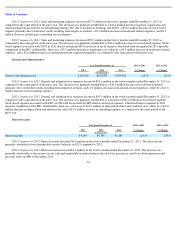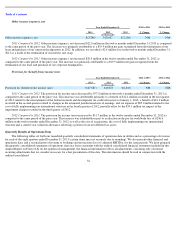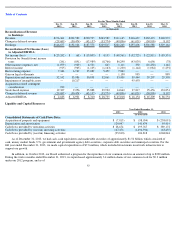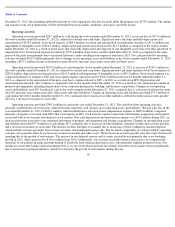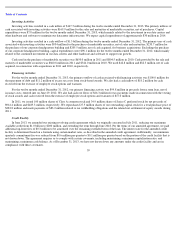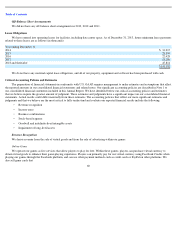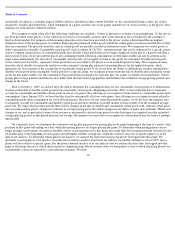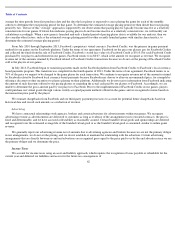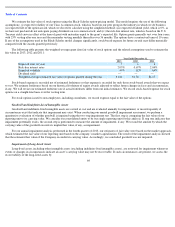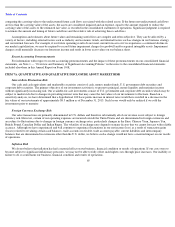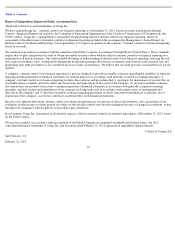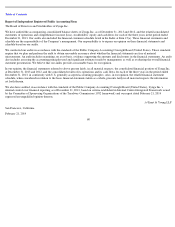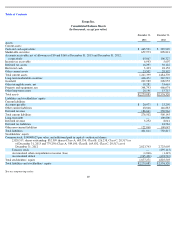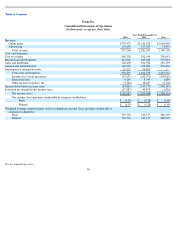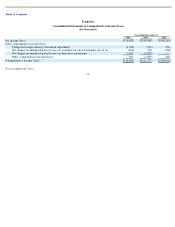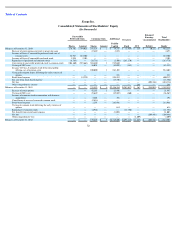Zynga 2013 Annual Report Download - page 67
Download and view the complete annual report
Please find page 67 of the 2013 Zynga annual report below. You can navigate through the pages in the report by either clicking on the pages listed below, or by using the keyword search tool below to find specific information within the annual report.
Table of Contents
events that have been recognized in our financial statements or tax returns. The measurement of current and deferred tax assets and liabilities is
based on provisions of enacted tax laws; the effects of future changes in tax laws or rates are not anticipated. If necessary, the measurement of
deferred tax assets is reduced by the amount of any tax benefits that are not expected to be realized based on available evidence. We account for
uncertain tax positions by reporting a liability for unrecognized tax benefits resulting from uncertain tax positions taken or expected to be taken
in a tax return. We recognize interest and penalties, if any, related to unrecognized tax benefits in provision for income taxes.
In June 2013, the Financial Accounting Standards Board ratified Emerging Issues Task Force (“EITF”) Issue 13-C, “Presentation of an
Unrecognized Tax Benefit When a Net Operating Loss Carryforward, a Similar Tax Loss, or a Tax Credit Carryforward Exists”
which concludes
an unrecognized tax benefit should be presented as a reduction of a deferred tax asset when settlement in this manner is available under the tax
law. We will adopt this amendment in the first quarter of 2014. We do not expect our adoption of this standard to have a material impact on our
financial statements.
Business Combinations
In line with our growth strategy, we have completed acquisitions to expand our social games and mobile offerings, obtain employee talent,
and expand into new markets. We account for acquisitions of entities that include inputs and processes and have the ability to create outputs as
business combinations. We allocate the purchase price of the acquisition, which includes the estimated acquisition date fair value of contingent
consideration, to the tangible assets, liabilities and identifiable intangible assets acquired based on their estimated fair values. The excess of the
purchase price over those fair values is recorded as goodwill. Determining the fair value of such items requires judgment, including estimating
future cash flows or estimating the cost to recreate an acquired asset. If actual results are lower than estimates, we could be required to record
impairment charges in the future. Acquired intangible assets are amortized over their estimated useful lives. Intangible assets with indefinite
lives are not amortized but rather tested for impairment annually, or more frequently if circumstances exist which indicate an impairment may
exist.
Acquisition-related expenses and restructuring costs are expensed as incurred. During the one-year period beginning with the acquisition
date, we may record certain purchase accounting adjustments related to the fair value of assets acquired and liabilities assumed against goodwill.
After the final determination of the fair value of assets acquired or liabilities assumed, any subsequent adjustments are recorded to our
consolidated statements of operations. We record changes in the fair value of contingent consideration liabilities within operating expenses in
our consolidated statement of operations each reporting period.
Stock-Based Expense
Prior to our IPO in December 2011, we granted ZSUs to our employees that generally vest upon the satisfaction of both a service-based
condition of up to four years and a liquidity condition, the latter of which was satisfied in connection with our IPO in December 2011. Because
the liquidity condition was not satisfied until our IPO, in prior periods, we had not recorded any expense relating to the granting of our ZSUs. In
the fourth quarter of 2011, after the IPO, we recognized $510 million of stock-based expense associated with ZSUs that vested in connection
with our IPO. This expense is in addition to the stock-based expense we recognize related to outstanding equity awards other than ZSUs as well
as expenses related to ZSUs or other equity awards that may be granted in the future.
For ZSUs granted prior to the IPO, and for awards subject to performance conditions, we recognize stock-based expense using the
accelerated attribution method, net of estimated forfeitures, in which compensation cost for each vesting tranche in an award is recognized
ratably from the service inception date to the vesting date for that tranche. For ZSUs granted after the IPO, which are only subject to a service
condition, we recognize stock-based expense on a ratable basis over the requisite service period for the entire award.
63


